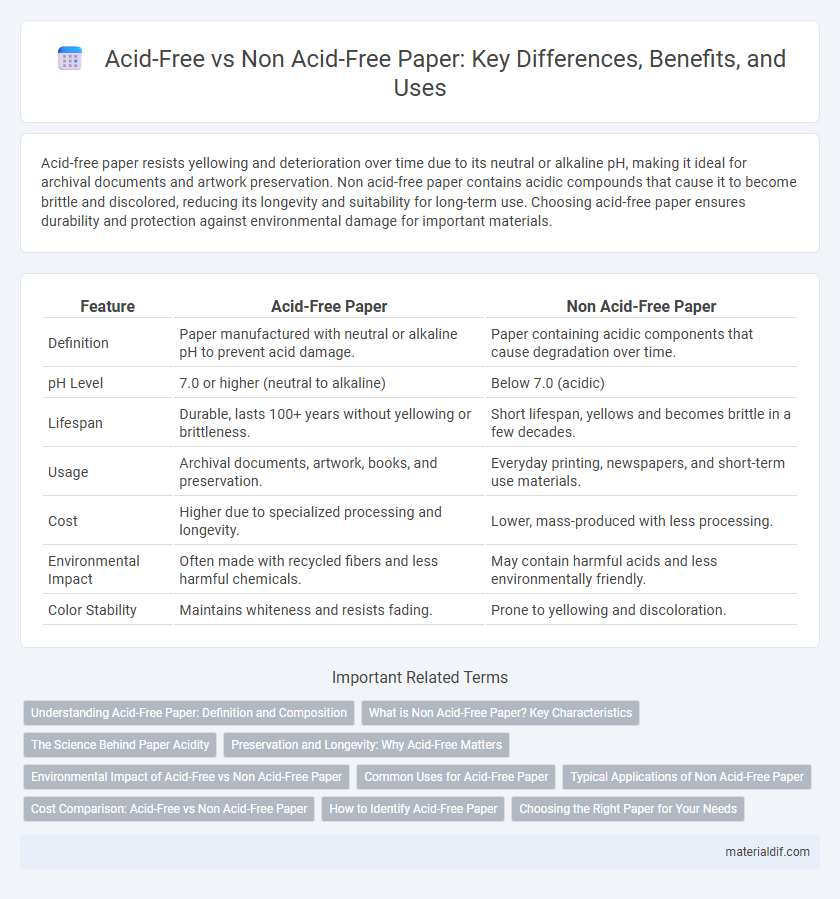Acid-free paper resists yellowing and deterioration over time due to its neutral or alkaline pH, making it ideal for archival documents and artwork preservation. Non acid-free paper contains acidic compounds that cause it to become brittle and discolored, reducing its longevity and suitability for long-term use. Choosing acid-free paper ensures durability and protection against environmental damage for important materials.
Table of Comparison
| Feature | Acid-Free Paper | Non Acid-Free Paper |
|---|---|---|
| Definition | Paper manufactured with neutral or alkaline pH to prevent acid damage. | Paper containing acidic components that cause degradation over time. |
| pH Level | 7.0 or higher (neutral to alkaline) | Below 7.0 (acidic) |
| Lifespan | Durable, lasts 100+ years without yellowing or brittleness. | Short lifespan, yellows and becomes brittle in a few decades. |
| Usage | Archival documents, artwork, books, and preservation. | Everyday printing, newspapers, and short-term use materials. |
| Cost | Higher due to specialized processing and longevity. | Lower, mass-produced with less processing. |
| Environmental Impact | Often made with recycled fibers and less harmful chemicals. | May contain harmful acids and less environmentally friendly. |
| Color Stability | Maintains whiteness and resists fading. | Prone to yellowing and discoloration. |
Understanding Acid-Free Paper: Definition and Composition
Acid-free paper is manufactured using alkaline substances like calcium carbonate to maintain a neutral or slightly basic pH, preventing degradation over time. Unlike non acid-free paper, which contains lignin and acidic additives that cause yellowing and brittleness, acid-free paper ensures durability and longevity, making it ideal for archival and artistic purposes. The composition of acid-free paper typically includes purified wood fibers and buffering agents to neutralize acids, enhancing its resistance to environmental factors and chemical decay.
What is Non Acid-Free Paper? Key Characteristics
Non acid-free paper contains lignin and acidic residues that cause it to yellow and deteriorate over time, making it unsuitable for long-term preservation. It typically has a lower pH level, often below 7, which accelerates the degradation process and reduces durability. Commonly used in everyday printing and packaging, non acid-free paper is more affordable but less stable compared to acid-free alternatives.
The Science Behind Paper Acidity
Paper acidity is measured by its pH level, with acid-free paper having a neutral or slightly alkaline pH, typically 7 or above, ensuring greater longevity and resistance to yellowing and brittleness. Non acid-free paper contains acidic compounds, often from lignin, that cause it to degrade faster through acid hydrolysis, leading to discoloration and weakened fibers over time. The science behind paper acidity directly impacts archival quality, making acid-free paper the preferred choice for preserving documents, artworks, and photographs.
Preservation and Longevity: Why Acid-Free Matters
Acid-free paper resists yellowing and deterioration over time, ensuring long-term preservation of documents, photographs, and artwork. Non acid-free paper contains lignin and acids that break down fibers, leading to brittleness and discoloration within years. Archival quality acid-free paper is essential for maintaining the integrity and longevity of valuable materials.
Environmental Impact of Acid-Free vs Non Acid-Free Paper
Acid-free paper significantly reduces environmental degradation due to its longer lifespan and resistance to yellowing and brittleness, leading to less frequent disposal and lower resource consumption. Non acid-free paper decomposes more quickly, releasing acidic compounds that can harm soil and waterways, contributing to pollution and ecosystem imbalance. Choosing acid-free paper supports sustainable forestry practices and minimizes the carbon footprint associated with paper production and waste management.
Common Uses for Acid-Free Paper
Acid-free paper is widely used in archival documents, fine art prints, and important legal papers due to its long-lasting durability and resistance to yellowing or deterioration. Museums and libraries prefer acid-free paper for preserving historical manuscripts and photographs, ensuring they remain intact over decades. Furthermore, acid-free paper is ideal for scrapbooking, certificates, and professional presentations where preservation quality is essential.
Typical Applications of Non Acid-Free Paper
Non acid-free paper is commonly used in everyday printing tasks, packaging materials, and newspapers where longevity is not a priority. Its lower production cost makes it ideal for short-term applications such as flyers, receipts, and disposable products. However, this type of paper tends to yellow and deteriorate over time due to its acidic content.
Cost Comparison: Acid-Free vs Non Acid-Free Paper
Acid-free paper typically costs 20-50% more than non acid-free paper due to its specialized manufacturing process that prevents yellowing and deterioration over time. While non acid-free paper is cheaper upfront, it often requires more frequent replacement, increasing long-term expenses for archival projects, professional printing, and document preservation. Choosing acid-free paper is a cost-effective investment for maintaining document integrity and durability in museums, libraries, and art galleries.
How to Identify Acid-Free Paper
Acid-free paper can be identified by checking for a pH level of 7 or above, ensuring it is neutral or slightly alkaline to prevent yellowing and deterioration over time. Look for labels or certifications such as "acid-free," "archival quality," or "lignin-free" on packaging to guarantee the paper's longevity and preservation properties. A simple test involves placing a drop of calcium carbonate solution on the paper; acid-free paper will not react or discolor, confirming its neutrality.
Choosing the Right Paper for Your Needs
Acid-free paper offers superior durability and resistance to yellowing, making it ideal for archival documents, artworks, and important records that require long-term preservation. Non acid-free paper contains acids that accelerate deterioration, suitable primarily for everyday printing and temporary use where longevity is not a concern. Selecting acid-free or non acid-free paper depends on the project's purpose, desired lifespan, and environmental factors such as humidity and light exposure.
Acid-Free Paper vs Non Acid-Free Paper Infographic

 materialdif.com
materialdif.com